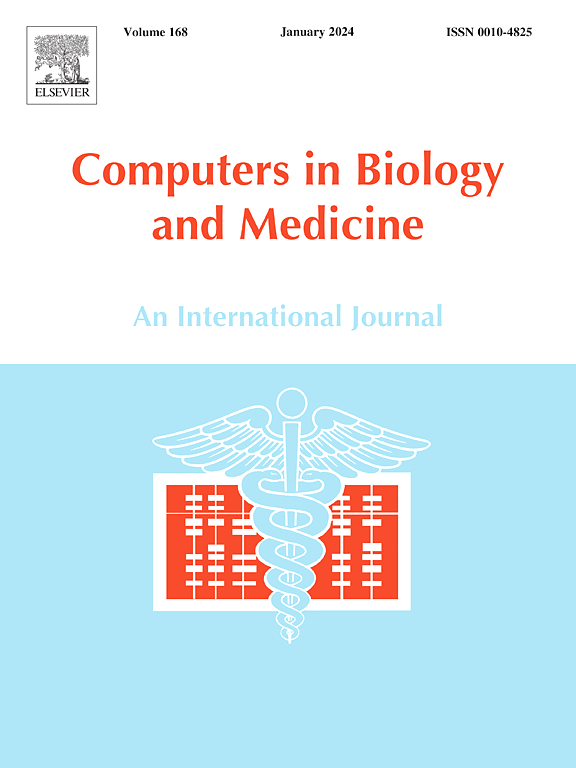用计算机测定唾液和口腔呼出飞沫的时间病毒载量
IF 6.3
2区 医学
Q1 BIOLOGY
引用次数: 0
摘要
背景与目的严重急性呼吸综合征-冠状病毒-2 (SARS-CoV-2)引发的公共卫生危机凸显了深入了解咳嗽过程中病毒复制和再释放机制的重要性。方法采用宿主细胞动力学(Host-cell dynamics, HCD)模型表征SARS-CoV-2在口腔唾液中的复制动力学,并根据临床数据优化拟合参数,提高病毒载量预测精度。将欧拉壁膜模型与HCD模型相结合,量化咳嗽时呼出飞沫中的病毒载量。此外,还考虑了口腔几何形状的变化,以确定其对携带病毒的飞沫传播风险的影响。结果shcd模型显示,口腔病毒载量迅速上升,在潜伏期(−5 ~−1天)达到107拷贝/mL左右的峰值,提示口腔是病毒早期复制的主要位点。综合分析发现,呼出飞沫的病毒载量与唾液的病毒载量高度相关,这意味着口腔区域的高病毒载量会加剧无症状期的传播风险。此外,口腔结构的差异导致了逸出飞沫携带的病毒载量的变化,从而影响了传播性的定量评估。结论本研究系统分析了SARS-CoV-2口腔感染动态。我们的hcd -欧拉壁膜耦合方法提供了一种定量分析工具,可以全面评估从初始感染到个体间传播的所有过程,揭示口腔在病毒复制和液滴逃逸中的关键作用。这些发现为个人防护、空气传播风险评估和优化公共卫生策略提供了科学见解。本文章由计算机程序翻译,如有差异,请以英文原文为准。
In silico determination of the temporal viral loads in the saliva and exhaled droplets from the oral cavity
Background and objective
The public health crisis triggered by the severe acute respiratory syndrome-coronavirus-2 (SARS-CoV-2) highlights the importance of the in-depth understanding of viral replication and re-emission mechanisms during coughing.
Methods
In this study, we used a Host-cell dynamics (HCD) model to characterize the replication kinetics of SARS-CoV-2 in the saliva of the oral cavity and optimized the fitting parameters based on clinical data to improve the viral load prediction accuracy. The Eulerian wall film model was integrated with the HCD model to quantify the viral load in the exhaled droplets during coughing. Additionally, variations in the oral cavity geometry were considered to determine its impact on the transmission risk of virus-laden droplets.
Results
HCD model showed that viral load in the oral cavity rose rapidly and peaked at around 107 copies/mL during the incubation period (days −5 to −1), suggesting it as a major site for early viral replication. Integrated analysis revealed that the viral load of exhaled droplets was highly correlated with that of saliva, implying that a high viral load in the oral region exacerbates the transmission risk in the asymptomatic phase. Moreover, differences in oral cavity structure led to variations in the viral load carried by escaped droplets, thereby affecting the quantitative assessment of transmissibility.
Conclusions
This study systematically analyzed the dynamics of SARS-CoV-2 infection in the oral cavity. Our HCD-Eulerian wall film coupling approach provides a quantitative analytical tool to comprehensively assess all processes, from initial infection to inter-individual transmission, revealing the critical roles of the oral cavity in viral replication and droplet escape. These findings offer scientific insights for individual protection, airborne transmission risk assessment, and optimization of public health strategies.
求助全文
通过发布文献求助,成功后即可免费获取论文全文。
去求助
来源期刊

Computers in biology and medicine
工程技术-工程:生物医学
CiteScore
11.70
自引率
10.40%
发文量
1086
审稿时长
74 days
期刊介绍:
Computers in Biology and Medicine is an international forum for sharing groundbreaking advancements in the use of computers in bioscience and medicine. This journal serves as a medium for communicating essential research, instruction, ideas, and information regarding the rapidly evolving field of computer applications in these domains. By encouraging the exchange of knowledge, we aim to facilitate progress and innovation in the utilization of computers in biology and medicine.
 求助内容:
求助内容: 应助结果提醒方式:
应助结果提醒方式:


